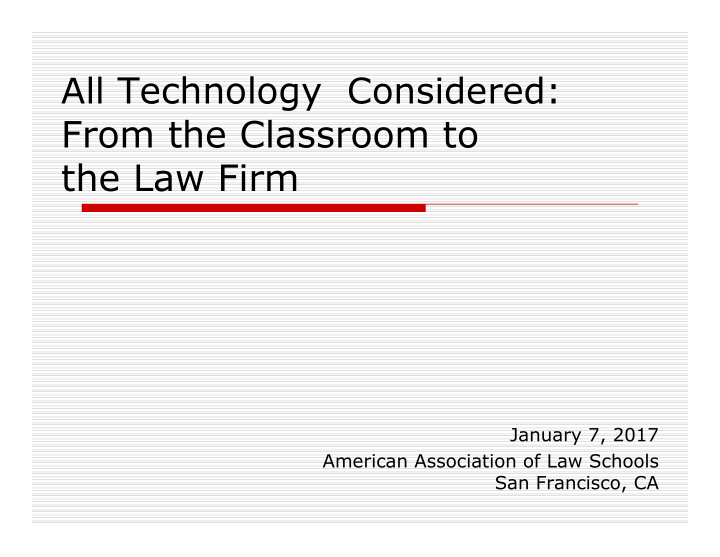



All Technology Considered: From the Classroom to the Law Firm January 7, 2017 American Association of Law Schools San Francisco, CA
The Line Up Moderator : Susan Nevelow Mart Speakers : Roger Skalbeck : Educational Technology Rebecca Tram m ell : Online Learning/Courses Holly Riccio : Law Firm Technology
The Plan
EDUCATI ONAL TECH Roger V. Skalbeck
Technology: All Around Us Fish! https://flic.kr/p/q6AnJz https://news.greylock.com/this-is-water-f989bd158191
Technology: All Around Us
ENHANCE LEARNI NG TECHNOLOGY TO
Polling Software Responses Upvotes Downvotes Final exams 15 1 The crushing debt 11 1 Not living up to expectations I have set for myself. 10 0 Dying. 9 1 failing 7 1 finding out I'm much dumber than expected 7 1 Not living up to expectations 7 0 crippling anxiety and no free time 6 1 looking like an idiot among smart people 5 1 Not finishing where I want to in the class 5 1
Polling Software
I NTEGRATI NG TECH I NTO COURSEW ORK
https://flic.kr/p/9m7Ksi https://flic.kr/p/p5JquD
Word: Styles + Structure
Excel: Charts + Data Tools
Practice Management Tools
ADVANCED TECH SKI LLS + STANDALONE COURSES
Standalone Law+Tech Courses
Questions for Table Discussions 1. How do we leverage tech to enhance learning in law school classes? 2. How can we integrate tech into doctrinal courses and existing programs? 3. What advanced offerings can and should we provide?
Rebecca Trammell ONLI NE LEARNI NG / COURSES
& Distance Learning ABA Standard 306 15 total distance credits 28 credits enrollment rule Faculty/student interaction required Student/student interaction required Monitor student activity Meet all other ABA Standards Learning outcomes Assessment
Online (Distance) Learning Lingo F2F = Face to face Asynchronous Blended/Flipped Classroom Synchronous ABA allows 1/3 online in any class
Online Education Programs Require online education policy Student identification process Learning objectives & assessment Adequate technical support Faculty Students
Online Learning Myths Teaching online is easier than F2F Online courses lack the rigor of F2F Online courses offer easy grades for students Online courses lack interaction
Online Learning Truths Teaching online is harder than teaching F2F Online courses equal & may surpass the rigor of F2F Online courses offer MORE student engagement & interaction then F2F
Online Education Programs Offer flexibility for school and faculty Support student interaction Increase faculty-student interaction Document student participation Increase assessment opportunities
Parts of an Online Course Announcements Assignments Calendar A/V Presentations Discussion Boards Narrated PowerPoint Introductions Projects Responses to professor posts Student initiated posts/questions Assigned Readings Posts about assigned readings Posts identifying similar/related readings/articles
Student Online Learning Positives Negatives Any time/any place course No way to “hide” access No way to “fake it” Reflection time before Requires self- responding to questions direction/motivation Convenience in scheduling Requires time management other courses & activities Requires participation All course content available throughout the course throughout the semester More direct accountability Constant feedback Requires more class Documents student preparation participation Mandates consistency & Increases assessment focus opportunities
Faculty Online Teaching Positives Negatives Student contact not limited to Student contact not limited scheduled class time to scheduled class time Rethinking class goals, activities Rethinking class goals, and assessments activities and assessments No students “hiding” Becoming comfortable with online technology Students better prepared for class Transitioning from in-person classroom instruction to an No restrictions on teaching in a online format specific classroom at specific times Maintaining student engagement Documents student participation Mandates consistent Increases assessment communication opportunities
Online Teaching Tools Learning Management Systems (LMS) LMS
Online Teaching Tools LMS Assessment Tools Quizzes Polling Course activity Individual user/all users Date range Time spent on activity
Don’t Forget These Online Tools Webcasts & Video Feeds Podcasts/Voice-over-slides YouTube, Camtasia PowerPoint & Beyond PowToon Prezi Keynote Prezentit
Link Online Education to Law Practice Proficiency in using technology Law office tools Law office communications - Filing -Discovery -Technology & professional ethics -Communication
Resources & Help www.wgdlle.com
Online Learning Is your school offering online courses? JD 1. Yes 2. No LL.M. 1. Yes 2. No Are you teaching an online course? 1. Yes 2. No planning to teach an online course? 1. Yes 2. No thinking about teaching online? 1. Yes 2. No
Questions for Table Discussion 1. Can law be taught successfully through online/distance courses? Why or Why not? 2. Are there law courses that should NOT be taught through online/distance courses? If so, which courses and why? 3. How would you prepare to teach an online/distance course? What issues, technology, strategies would you consider?
LAW FI RM TECHNOLOGY Holly Riccio
Law Firm Realities General Big Salaries, Big Bonuses, Big Expectations New Associates Care and Feeding Legal Tech Lexis and Westlaw Still King The Single Vendor Issue Intranets Changing User Experience Artificial Intelligence Influx…or Not
State of Legal Tech in Law Firms Varying Adoption Rates Less About Technology, More About Skill Set and Mindset “The real possibility for change in the future sits more with the mindset. It’s all about the law firm adopting its client’s worldview and innovating service delivery with those views in mind.” ― Randi Mayes, ILTA Executive Director
Legal Tech Initiatives Legal Tech Assessment Casey Flaherty Kia Tech Audit LTC4 Legal Technology Core Competencies Certification Coalition LTC4 Core Competency Learning Plans PLLIP-SIS Research Skills Audit IP, Corporate, Legislative History, Litigation, M&A, Securities, Tax
Questions for Table Discussions Are there core skills that law students learn that are transferrable and useful when it comes to adapting to new legal technologies? What are they? How are the applicable? Are there new skills law students should be learning? What are they? Do you have any ideas about how academic law librarians and law firm librarians could collaborate better to result in more legal tech- adept law students and lawyers?
THE END. THANK YOU.
Recommend
More recommend